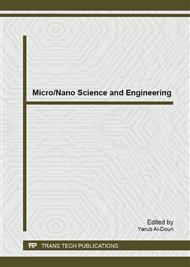[1]
U. Larsen, T. Johansen, and J. Schramm, Ethanol as a Fuel for Road Transportation, (2009).
Google Scholar
[2]
C. S. Goh and K. T. Lee, A visionary and conceptual macroalgae-based third-generation bioethanol (TGB) biorefinery in Sabah, Malaysia as an underlay for renewable and sustainable development, Renewable and Sustainable Energy Reviews, 14 (2010).
DOI: 10.1016/j.rser.2009.10.001
Google Scholar
[3]
X. Wang, X. Liu, and G. Wang, Two-stage hydrolysis of invasive algal feedstock for ethanol fermentation., Journal of integrative plant biology, 53 (2011) 246–52.
DOI: 10.1111/j.1744-7909.2010.01024.x
Google Scholar
[4]
J. Singh and S. Gu, Commercialization potential of microalgae for biofuels production, Renewable and Sustainable Energy Reviews, 14 (2010) 2596–2610.
DOI: 10.1016/j.rser.2010.06.014
Google Scholar
[5]
S. G. Wi, H. J. Kim, S. A. Mahadevan, D. -J. Yang, and H. -J. Bae, The potential value of the seaweed Ceylon moss (Gelidium amansii) as an alternative bioenergy resource., Bioresource technology, 100 (2009) 6658–6660.
DOI: 10.1016/j.biortech.2009.07.017
Google Scholar
[6]
H. Andriamanantoanina, G. Chambat, and M. Rinaudo, Fractionation of extracted Madagascan Gracilaria corticata polysaccharides: Structure and properties, Carbohydrate Polymers, 68 (2007) 77–88.
DOI: 10.1016/j.carbpol.2006.07.023
Google Scholar
[7]
M. H. Huesemann, L. Kuo, L. Urquhart, G. A. Gill, and G. Roesijadi, Acetone-butanol fermentation of marine macroalgae, Bioresource Technology, 108 (2012) 305–309.
DOI: 10.1016/j.biortech.2011.12.148
Google Scholar
[8]
S. S. Dhaliwal, H. S. Oberoi, S. K. Sandhu, D. Nanda, D. Kumar, and S. K. Uppal, Enhanced ethanol production from sugarcane juice by galactose adaptation of a newly isolated thermotolerant strain of Pichia kudriavzevii., Bioresource technology, 102 (2011).
DOI: 10.1016/j.biortech.2011.02.015
Google Scholar
[9]
M. Kanagasahapathy, H. Sasaki, S. Haldar, S. Yamasaki, and S. Nagata, Antibacterial activities of marine epibiotic bacteria isolated from brown algae of Japan, Annals of Microbiology, 56 (2006) 167–173.
DOI: 10.1007/bf03175000
Google Scholar
[10]
J. Park, J. Hong, H. Chul, S. Geun, S. Kim, J. Yoon, and Y. Jin, Bioresource Technology Use of Gelidium amansii as a promising resource for bioethanol : A practical approach for continuous dilute-acid hydrolysis and fermentation, Bioresource Technology, (2012).
DOI: 10.1016/j.biortech.2011.12.065
Google Scholar
[11]
G. L. Miller, Use of Dinitrosalicyclic Acid Reagent for Determination of Reducing Sugar, Analytical Chemistry, 31 (1959) 426–428.
DOI: 10.1021/ac60147a030
Google Scholar
[12]
Z. Anwar, M. Gulfraz, M. J. Asad, M. Imran, Z. Akram, S. Mehmood, A. Rehman, P. Anwar, and A. Sadiq, Bioethanol productions from rice polish by optimization of dilute acid pretreatment and enzymatic hydrolysis, African Journal of Biotechnology, 11 (2012).
DOI: 10.5897/ajb11.1145
Google Scholar
[13]
J. G. Black, Microbiology, seventh ed. John Wiley & SOns, Inc., Asia, (2008).
Google Scholar
[14]
Y. Khambhaty, K. Mody, M. R. Gandhi, S. Thampy, P. Maiti, H. Brahmbhatt, K. Eswaran, and P. K. Ghosh, Kappaphycus alvarezii as a source of bioethanol, Bioresource Technology, 103 (2012) 180–185.
DOI: 10.1016/j.biortech.2011.10.015
Google Scholar


